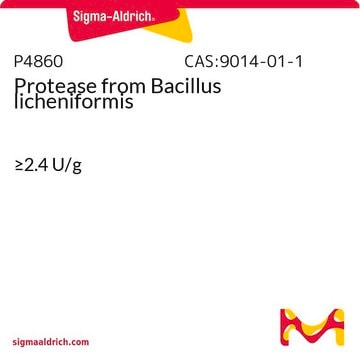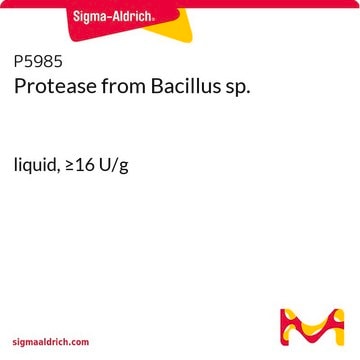P2143
Protease from Aspergillus saitoi
Type XIII, ≥0.6 unit/mg solid
Synonym(s):
Molsin
Sign Into View Organizational & Contract Pricing
All Photos(1)
About This Item
Recommended Products
biological source
Aspergillus sp. (Aspergillus saitoi)
type
Type XIII
form
solid
specific activity
≥0.6 unit/mg solid
foreign activity
alkaline protease, essentially free
storage temp.
−20°C
Application
Protease from Aspergillus saitoi has been used in a study to assess sequence coverage and resolution in hydrogen exchange of large proteins. It has also been used in a study to investigate the conversion of soybean curd isoflavone glycosides to their aglycones through β-glucosidase..
Biochem/physiol Actions
Protease from Aspergillus saitoi was shown to also function as a β-glucosidase.
Unit Definition
One unit will hydrolyze hemoglobin to produce color equivalent to 1.0 μmole (181 μg) of tyrosine per min at pH 2.8 at 37 °C (color by Folin-Ciocalteu reagent).
Signal Word
Danger
Hazard Statements
Precautionary Statements
Hazard Classifications
Eye Irrit. 2 - Resp. Sens. 1 - Skin Irrit. 2 - STOT SE 3
Target Organs
Respiratory system
Storage Class Code
11 - Combustible Solids
WGK
WGK 3
Flash Point(F)
Not applicable
Flash Point(C)
Not applicable
Certificates of Analysis (COA)
Search for Certificates of Analysis (COA) by entering the products Lot/Batch Number. Lot and Batch Numbers can be found on a product’s label following the words ‘Lot’ or ‘Batch’.
Already Own This Product?
Find documentation for the products that you have recently purchased in the Document Library.
Customers Also Viewed
E Ichishima et al.
The Biochemical journal, 339 ( Pt 3), 589-597 (1999-04-24)
For the construction of an overexpression system of the intracellular 1,2-alpha-mannosidase (EC 3.2.1.113) gene (msdS) from Aspergillus saitoi (now designated Aspergillus phoenicis), the N-terminal signal sequence of the gene was replaced with that of the aspergillopepsin I (EC 3.4.23.18) gene
Laetitia Cravello et al.
Rapid communications in mass spectrometry : RCM, 17(21), 2387-2393 (2003-10-31)
The combination of hydrogen exchange and mass spectrometry has been widely used in structural biology, providing views on protein structure and protein dynamics. One of the constraints is to use proteases working at low pH and low temperature to limit
Analysis of proteolytic degradation of a crude protein mixture using a surface acoustic wave sensor.
T M A Gronewold et al.
Biosensors & bioelectronics, 22(9-10), 2360-2365 (2006-11-03)
Degradation of a crude protein mixture by proteases with pH optima from acidic to basic was followed in real time using a surface acoustic wave biosensor in Love-wave geometry. Proteases EC 3.4.23.18 from Aspergillus saitoi, EC 3.4.21.62 from Bacillus licheniformis
Mizuho Nishinoaki et al.
Bioscience, biotechnology, and biochemistry, 72(2), 587-590 (2008-02-08)
An Aspergillus saitoi protease preparation, Molsin, was found to contain beta-glucosidase as well as protease activities. Application of Molsin to soybean curd improved its functionality by converting the contained isoflavone glycosides to their aglycones through beta-glucosidase, and also modified the
F J Moralejo et al.
Applied microbiology and biotechnology, 54(6), 772-777 (2001-01-11)
A gene encoding the sweet-tasting protein thaumatin (tha) with optimized codon usage was expressed in Aspergillus awamori. Mutants of A. awamori with reduced proteolytic activity were isolated. One of these mutants, named lpr66, contained an insertion of about 200 bp
Our team of scientists has experience in all areas of research including Life Science, Material Science, Chemical Synthesis, Chromatography, Analytical and many others.
Contact Technical Service












